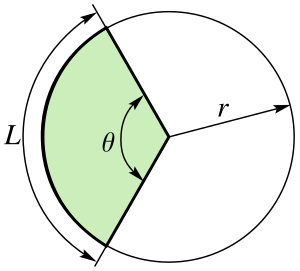Arc (geometry)

In geometry, an arc (symbol: ⌒) is a closed segment of a differentiable curve in the two-dimensional plane; for example, a circular arc is a segment of a circle, or of its circumference (boundary) if the circle is considered to be a disc. If the arc is part of a great circle (or great ellipse), it is called a great arc.
Except where stated otherwise, the arcs discussed below are arcs of circles.
Arc length
Length of an arc of a circle
The length of an arc of a circle with radius and subtending an angle (measured in radians) with the circle center — i.e., the central angle — equals . This is because
Substituting in the circumference
and solving for arc length, , in terms of yields
An angle of degrees has a size in radians given by
and so the arc length equals
A practical way to determine the length of an arc in a circle is to plot two lines from the arc's endpoints to the center of the circle, measure the angle where the two lines meet the center, then solve for L by cross-multiplying the statement:
- measure of angle/360 = L/Circumference.
For example, if the measure of the angle is 60 degrees and the Circumference is 24", then
- .
This is so because the circumference of a circle and the degrees of a circle, of which there are always 360, are directly proportionate.
Length of an arc of a parabola
If a point X is located on a parabola which has focal length and if is the perpendicular distance from X to the axis of symmetry of the parabola, then the lengths of arcs of the parabola which terminate at X can be calculated from and as follows, assuming they are all expressed in the same units.
This quantity, , is the length of the arc between X and the vertex of the parabola.[1]
The length of the arc between X and the symmetrically opposite point on the other side of the parabola is
The perpendicular distance, , can be given a positive or negative sign to indicate on which side of the axis of symmetry X is situated. Reversing the sign of reverses the signs of and without changing their absolute values. If these quantities are signed, the length of the arc between any two points on the parabola is always shown by the difference between their values of The calculation can be simplified by using the properties of logarithms:
This can be useful, for example, in calculating the size of the material needed to make a parabolic reflector or parabolic trough.
This calculation can be used for a parabola in any orientation. It is not restricted to the situation where the axis of symmetry is parallel to the y-axis.
Arc area
The area between an arc and the center of a circle is:
The area has the same proportion to the circle area as the angle to a full circle:
We can get rid of a on both sides:
By multiplying both sides by , we get the final result:
Using the conversion described above, we find that the area of the sector for a central angle measured in degrees is:
Arc segment area
The area of the shape limited by the arc and a straight line between the two end points is:
To get the area of the arc segment, we need to subtract the area of the triangle made up by the circle's center and the two end points of the arc from the area . See Circular segment for details.
Arc radius
Using the intersecting chords theorem (also known as power of a point or secant tangent theorem) it is possible to calculate the radius of a circle given the height and the width of an arc:
Consider the chord with the same end-points as the arc. Its perpendicular bisector is another chord, which is a diameter of the circle. The length of the first chord is and it is divided by the bisector into two equal halves, each with length The total length of the diameter is and it is divided into two parts by the first chord. The length of one part is the height of the arc, and the other part is the remainder of the diameter, with length Applying the intersecting chords theorem to these two chords produces:
whence:
so:
See also
Similar shapes:
External links
- Definition and properties of a circular arc With interactive animation
- Radius of an arc or segment With interactive animation
- A collection of pages defining arcs and their properties, with animated applets Arcs, arc central angle, arc peripheral angle, central angle theorem and others.
- Weisstein, Eric W. "Arc". MathWorld.
Notes and references
- ^ In this calculation, the square-root, q, must be positive. The quantity ln(a) is the natural logarithm of a, i.e. its logarithm to base "e".











































